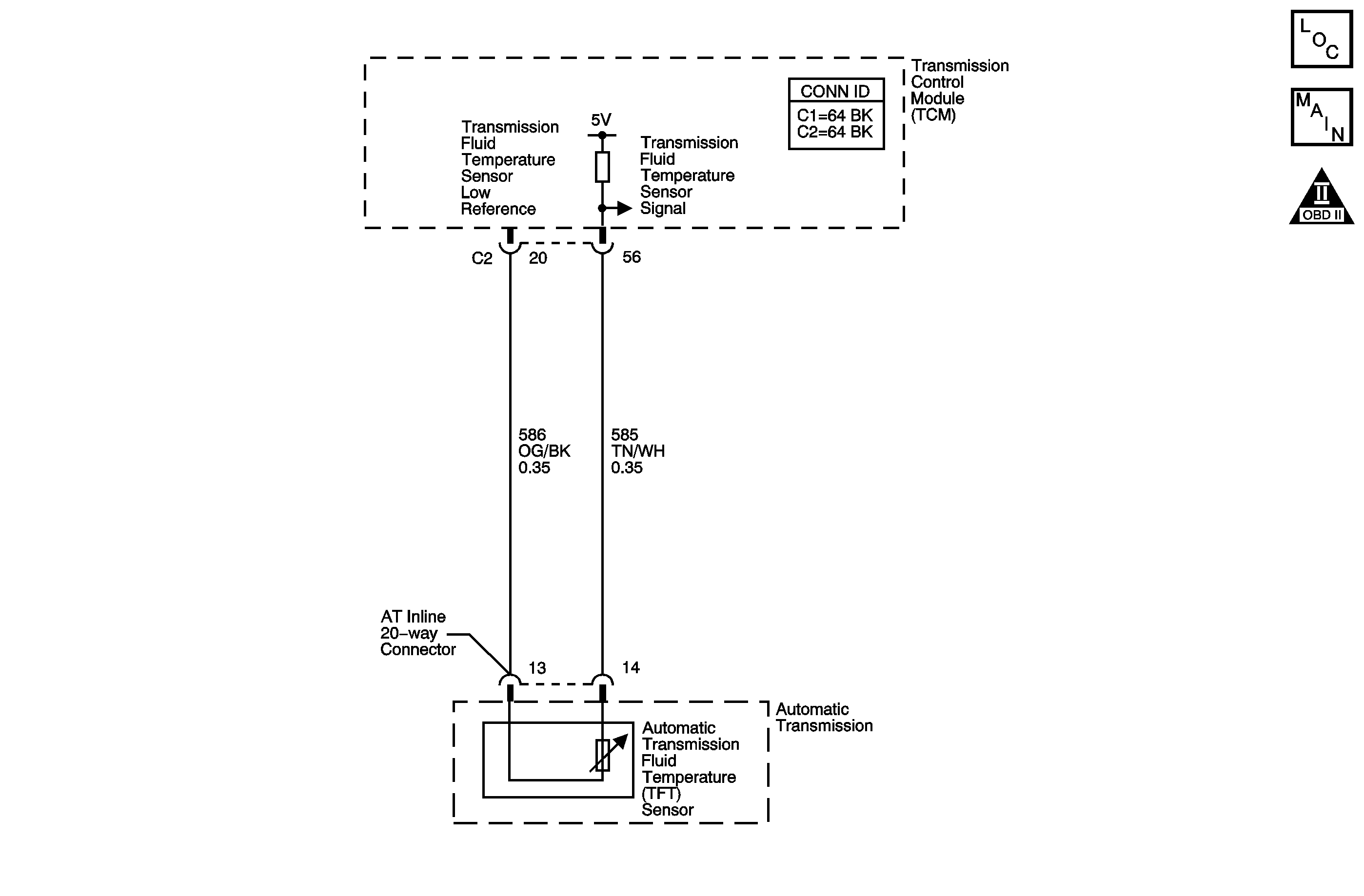
Circuit Description
The automatic transmission fluid temperature (TFT) sensor is part of the control solenoid valve assembly. The TFT sensor is a thermistor, or a resistor that changes resistance when the temperature changes. The sensor has a negative-temperature coefficient. This means that as the temperature increases, the resistance decreases, and as the temperature decreases, the resistance increases. The transmission control module (TCM) supplies a 5 volt reference signal to the sensor and measures the voltage drop in the circuit. When the transmission fluid is cold, the sensor resistance is high and the TCM detects high signal voltage. As the fluid temperature increases, the resistance of the sensor decreases, which lowers the signal voltage.
If the TCM detects a short to ground in the TFT sensor or signal circuit, then DTC P0712 sets. DTC P0712 is a type C DTC.
DTC Descriptor
This diagnostic procedure supports the following DTC:
DTC P0712 Transmission Fluid Temperature (TFT) Sensor Circuit Low Voltage
Conditions for Running The DTC
The engine speed is greater than 500 RPM for 5 seconds.
Conditions for Setting The DTC
The TCM detects a transmission fluid temperature of 151° C (304° F) or greater for 2 seconds.
Action Taken When the DTC Sets
| • | The TCM does not request the ECM to illuminate the malfunction indicator lamp (MIL). |
| • | The TCM will request the ECM to illuminate the service vehicle soon (SVS) lamp. |
| • | The TCM calculates a default transmission fluid temperature based on engine coolant temperature, intake air temperature and engine run time. |
| • | The TCM freezes garage shift transmission adaptive functions. |
| • | The TCM records the operating conditions when the Conditions for Setting the DTC are met. The TCM stores this information as Failure Records. |
| • | The TCM stores DTC P0712 in TCM history. |
Conditions for Clearing the SVS Lamp/DTC
| • | The TCM clears the SVS lamp request when the condition no longer exists. |
| • | A scan tool can clear the SVS lamp/DTC. |
| • | The TCM clears the DTC from TCM history if the vehicle completes 40 warm-up cycles without a non emission related diagnostic fault occurring. |
| • | The TCM cancels the DTC default actions when the fault no longer exists and the DTC passes. |
Diagnostic Aids
| • | Inspect the connectors at the TCM, the transmission, and all other circuit connecting points for an intermittent condition. Refer to Testing for Intermittent Conditions and Poor Connections in Wiring Systems. |
| • | Inspect the circuit wiring for an intermittent condition. Refer to Testing for Electrical Intermittents in Wiring Systems. |
Test Description
The numbers below refer to the step numbers on the diagnostic table.
-
This step tests the ability of the TCM to detect an open circuit. If the TCM recognizes the open, this eliminates the TCM and the wiring up to the transmission connector. The fault must be internal to the transmission.
-
Because the TFT is an integral part of the control solenoid valve assembly, the control solenoid valve assembly must be replaced.
Step | Action | Values | Yes | No | ||||
|---|---|---|---|---|---|---|---|---|
1 | Did you perform the Diagnostic System Check - Vehicle? | -- | Go to Step 2 | Go to Diagnostic System Check - Vehicle in Vehicle DTC Information | ||||
2 |
Important:
Does the scan tool display transmission fluid temperature equal to or greater than the specified value? | 151°C (304°F) | Go to Step 3 | Go to Intermittent Conditions in Engine Controls - 2.2L (L61) | ||||
Does the scan tool display transmission fluid temperature equal to the specified value? | -40°C (-40°F) | Go to Step 5 | Go to Step 4 | |||||
4 | Test the TFT sensor signal circuit from the AT inline 20-way connector to the TCM for a short to ground. Refer to Testing for Short to Ground and Wiring Repairs in Wiring Systems. Did you find and correct the condition? | -- | Go to Step 7 | Go to Step 6 | ||||
Replace the control solenoid valve assembly. Refer to Control Valve Body Assembly Disassemble . Is the action complete? | -- | Go to Step 7 | -- | |||||
6 | Replace the TCM. Refer to Control Module References in Computer/Integrating Systems for replacement, set-up and programming. Is the action complete? | -- | Go to Step 7 | -- | ||||
7 | Perform the following procedure in order to verify the repair:
Has the test run and passed? | -- | Go to Step 8 | Go to Step 2 | ||||
8 | With the scan tool, observe the stored information, capture info and DTC info. Does the scan tool display any DTCs that you have not diagnosed? | -- | Go to Diagnostic Trouble Code (DTC) List - Vehicle in Vehicle DTC Information | System OK |
